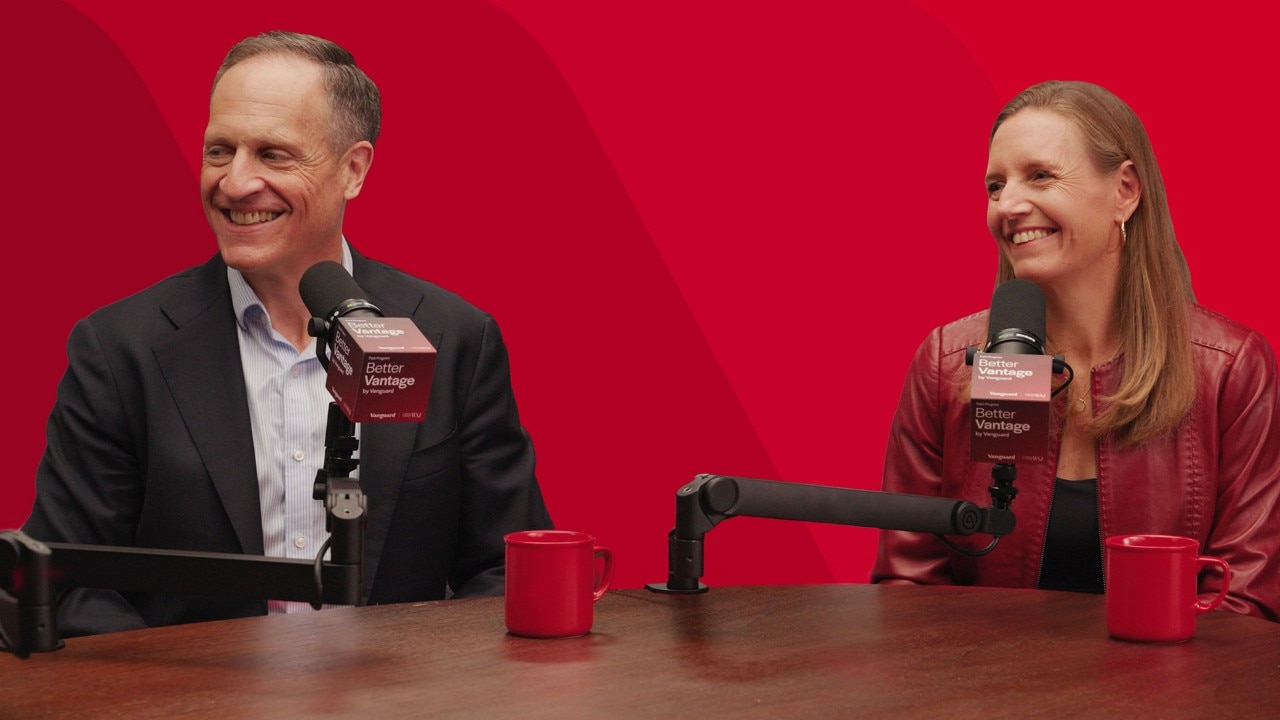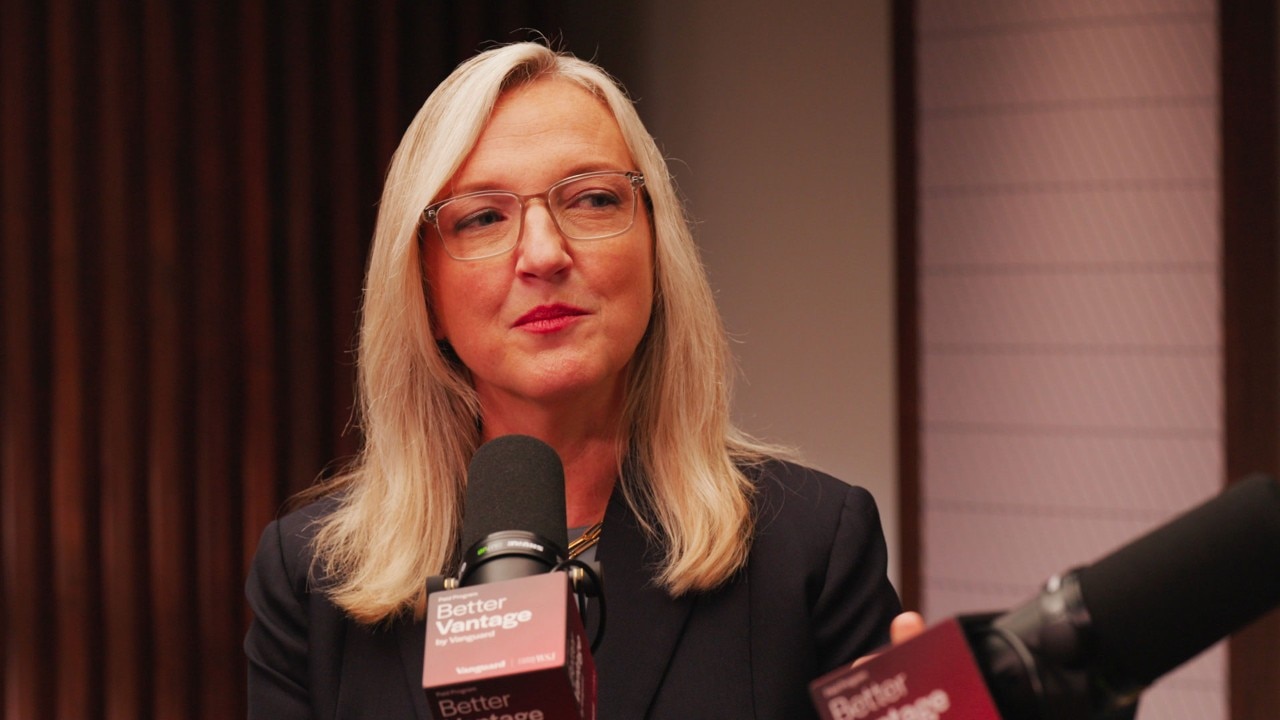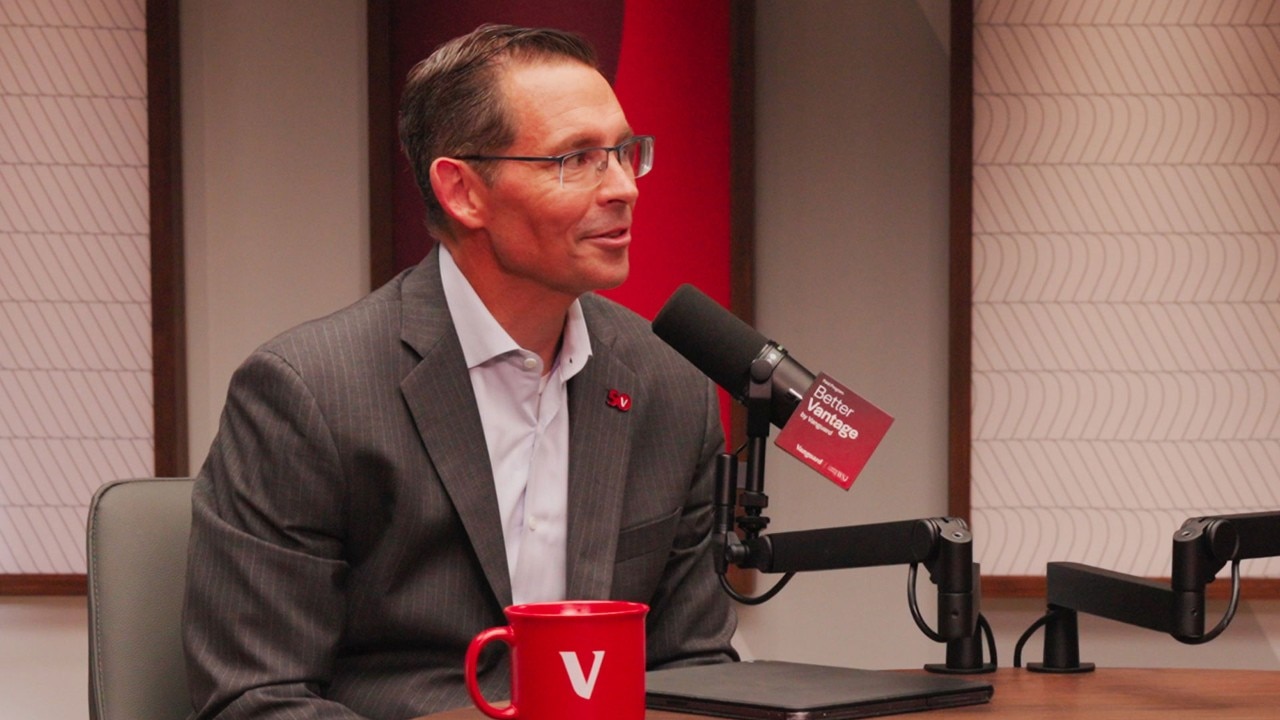Better Vantage podcast
Tax-saving strategies for savvy investors
October 15, 2025
Read the transcript
Christine Kashkari: Welcome to Season 1 of Better Vantage by Vanguard, a podcast series hosted by Custom Content from WSJ and Vanguard. I'm your host, Christine Kashkari, editorial director at WSJ Custom Programming, and I'd like to introduce my co-host in this series and the resident expert, Joe Davis, global chief economist at Vanguard.
Joe Davis: Thanks, Christine. Really excited about today's episode. We're going to hear from an expert who really can help us think through potentially harnessing 1 or 2% higher after-tax returns and some really exciting, what he calls off-label, tax-savvy strategies—many of which I was not aware of, and I've been in the business for 20 years. So Christine, over to you.
Christine: When you talk about taxes, usually people's eyes glaze over. But please pay attention, because coming up is a lot of very useful advice from our special guest today, Joel Dickson, global head of advice methodology at Vanguard. Joel, welcome.
Joel Dickson: Thank you very much.
Christine: Tax efficiency is your expertise, and today's conversation is all about maximizing after-tax returns and minimizing costs. But actually, it’s really all about managing or doing what you can control.
Joel: Often the things that are sexy and get all the commentary are the things that probably matter a little bit more on the margin than matter from the high level.
If there's one thing that people should focus on in terms of maximizing their after-tax returns or accumulating after-tax wealth, it is maximize tax-advantaged account opportunities. That by far makes the biggest impact—orders of magnitude more than other things. Other things are kind of tweaking along the sides.
Whether you're just an investor with W2 income and access to a 401(k) plan, or whether you are a high net worth investor that owns your own business and has all sorts of ideas for bequests and intergenerational wealth transfer, the first place is to understand and use the tax-preferenced options or vehicles that are available for you.
Joe: So harness the tax code to your advantage.
Joel: Absolutely.
Christine: You'll be proud of me. I'm at least passing that low bar of maximizing my contributions on my 401(k). So for a lot of people, that tax efficiency seems pretty obvious. What do you think is a hurdle for most people in appreciating the numerous things they can do that's under their control?
Joel: The biggest hurdle for many is, there is just this pain of people paying taxes. They fill out their tax form and it’s “oh, I have tax due.” That actually can be a good thing at times.
Joe: Whoa, whoa, whoa. What do you think? The higher the number, the better?
Joel: I didn't say that. However, often people think about tax efficiency as just deferring taxes as long as possible. As long as you're doing that, you're in good shape. That couldn't be more incorrect in many cases.
Joe: Tell me more about that.
Joel: For example, when you think about your 401(k), at some point you'll have to start withdrawing from that 401(k), say in retirement, to maintain some retirement income pieces. Well, we have these things in traditional 401(k) investing and IRA investing-- required minimum distributions—right now at age 73, and in a few years it goes up to 75. There's a certain amount you are required to take from those accounts every year, and for most people that's taxable income at ordinary income tax rates.
But if instead you start taking withdrawals from those accounts before you have to, there are many instances where your total lifetime taxes and after-tax wealth is greater by spreading that out. If you continue to let it grow and grow within the 401(k), and you get to age 73 or 75 and start having to take it out, it's possible that because the amount you have to take out depends on your account balance and your age, that you might be getting so much income that it’s pushing you into higher tax brackets. Whereas you could have evened out your tax exposure by instead taking some money prior to age 73, managing a multi-year tax plan.
Joe: You make a compelling argument. What are some other things that pull against conventional wisdom?
Joel: Why do we diversify an investment portfolio? Because we don't know what the market is going to deliver over the next 5, 10, or 30 years. We have different asset classes and think about correlations because we're managing that unknown. We know we’re going to look back 20 years from now and sort of say, I wish I would have had it all in whatever stock, but we don’t know that going in.
Similarly, there's a lot of tax risk in the system. While you may have an idea of where you might be in the future, you really don't know. There's a similar argument to think from an investment vehicle standpoint, a contribution standpoint, and how you’re saving, to diversify tax risk for the future—some accounts are tied to future tax rates, others to current tax rates.
Roth is tied to after-tax dollars today. Assuming laws don't change, you lock in the tax rate you're paying on that investment. In the future, you don't have to worry about where taxes are. That pays off in a world in which your tax burden is somewhat higher. Even if the tax rate goes down, you might be better off with a Roth approach. That piece of it helps diversify that risk that tax rates might actually increase. So having a combination of these exposures to future tax rate risk is important.
Joe: So it's not just about converting everything to Roth?
Joel: If you want to get even more advanced, no one should be all Roth.
Joe: Is that controversial?
Joel: If everyone did all their long-term savings in a Roth and the rules stay as they are, when you take it out you have no taxable income. When deciding to contribute to Roth or traditional, you might think you'll have a higher tax rate in the future, so you contribute to Roth. But if you don't, you should have been in a traditional IRA or 401(k). There's an endogeneity problem in how you mix these investment vehicles.
People talk about pre-tax and after-tax dollars as the same thing, but they're not. If you're contributing the same amount of after-tax dollars as pre-tax dollars, that's actually a higher effective savings rate.
For example, someone under 50 can choose between traditional IRA and Roth IRA for contributions. The current limit is $7,000 a year. $7,000 pre-tax is less money saved than $7,000 post-tax, because of the tax equivalent amount of that tax deduction. If you're in a 30% tax bracket, a $7,000 contribution to a traditional IRA gives you $2,100 of tax savings, but you can't contribute that $2,100 in the traditional IRA because you've already hit the maximum contribution of $7,000.
Joe: How about on the asset side? It’s on the investment side, right? I have a 401(k), some balanced portfolio, and additional savings in IRAs and a brokerage account. How should I be thinking about taxes there?
Joel: There’s certainly some things you can do. Again, I go back to the first thing. Even in a case where you’re finding you have a lot of other cash flow and then you can fund other types of investments and so forth. First, maximize opportunities on the tax-deferred side. If you have money outside of tax-advantaged vehicles, then you start hearing concepts like asset location or tax-loss harvesting—strategies to use with taxable accounts to potentially increase after-tax return.
Asset location is a good example, where there may be a role for more or less tax-efficient investments to be placed in accounts where you can take advantage of that efficiency.
Christine: The recommendations you're giving are really tailored to what more of us can do and what is under our control. I wanted to take advantage of being next to a tax expert. Sorry, Joe.
Joe: Tax girl. *laughs* I think she's actually leaning.
Christine: I heard you were a self-identified tax geek. My question is probably simple for you, but for us: I have two kids, 6 and 4, and we've enrolled them each in a 529 plan with Vanguard. That's where they've been since they were born. Auto-increase 2% to reflect the federal inflation rate.
Joel: You're doing the right thing at the macro level to set your kids and your saving strategy up for longer-term success. If you want to fine-tune it, that's fine, but you're 95% of the way there.
What you’re highlighting is, we've created so many different investment vehicles targeted to specific goals. This is another way to take advantage of tax-advantaged opportunities since 529 is a tax-advantaged account dedicated to education savings. I actually have a 529 plan in my name.
Joe: Are you getting another PhD or something?
Joel: The reason is it's another tax-advantaged account I can take advantage of. What am I going to do with this money down the road? I don't know yet. What I do know is I'm getting tax-advantaged growth that I'm not paying for each year, which I would be if it were in a brokerage account. I'm getting a bit of a tax deduction at the state level for contributions. Eventually, it will go to my heirs, and I'll transfer the beneficiaries. There are gift tax considerations and generation-skipping things to think about, but ultimately, I know I'll be able to pass it in some way and get the benefit of that tax efficiency today.
This is what I call off-label uses of accounts. One of my pet peeves in the tax efficiency space is also an opportunity: complexity.
Joe: You telling me I should have a 529 even though I’m not planning to go back to school?
Joel: You could use some further education. *laughs* The complexity of the tax code and vehicles provides opportunities to save for other things at the same time using those accounts.
Joe: Now you got me interested. What other off-label uses are there? The 529 is a great one—any other candidates?
Joel: Absolutely. Under recent tax law changes, you can use a certain amount of 529 assets to fund Roth IRAs for beneficiaries. My kids' Roth IRA contributions are being funded from their overfunded 529 plan for the next few years.
Similarly, health savings accounts (HSAs) are available for those with high-deductible health plans and have significant contribution limits. They're often used to save for out-of-pocket medical expenses, but there are opportunities for longer-term retirement savings by using HSAs.
You don't have to reimburse yourself from an HSA immediately. You can warehouse receipts and reimburse yourself 20 years later if you want. You can use this as a multi-year savings vehicle. In addition, for non-medical expenses, if you withdraw from the HSA, there's a 20% penalty, but if you're age 65, there's no penalty for non-healthcare expense withdrawals. At that point, it's like a traditional IRA or a traditional 401(k)—you made a tax-deductible contribution when you contributed to the HSA because you have what’s called this triple tax-free nature of HSAs. Tax deduction on the way in, tax deferred while in, and non-taxed on the way out if used for medical expenses. If you’re over age 65, you lose that third leg of the triple tax-free, but then that’s just what a typical 401(k) contribution looks like, so it’s no worse. So you can use this as long-term retirement savings.
The third off-label use is Roth IRAs as emergency savings vehicles. You contribute after-tax dollars to a Roth IRA, and if you take that money out, there's no further tax due or penalty, regardless of age or how long the account has been open. Yes, it might be in your head that you’re thinking about this for a retirement goal. But let’s face it—life happens, and if you need access to money in a liquid, non-penalty type of way, Roth IRA contributions can be one source of emergency savings.
Christine: How do you get your message out there? How do you educate plan sponsors who may not be aware of these efficiencies?
Joel: Complexity in the U.S. tax code is both a problem and an opportunity. How do you acquire that little bit of knowledge that can be most beneficial? The 80/20 rule: maximize tax-deferred accounts, then think through tax diversification. You don't know what future tax rates will be.
Christine: For me, my key takeaways are to diversify your tax risk and the triple tax-free concept of HSAs. I will get into the HSA.
Joe: Well I’ve been thinking too much on the investment side, Joel, and that’s what I’m more comfortable with and less on the financial planning and your tax location. So I think it’s been great.
Christine: Joe loves going to cocktail parties and he needs help sounding smart about tax efficiency strategies. So can you help him out with one key takeaway that he can take back?
Joel: Here’s the problem with that. I find at those same cocktail parties that people will walk away from me when I start talking about that piece. *laughs*
In many ways, you can significantly enhance your returns on your portfolio by being more careful about taxes. Whether that be 1%, 2% a year on average across the portfolio, by maximizing tax advantaged accounts, thinking about diversification of your tax risk, etc. Tax efficiency really matters in financial planning, especially for estate planning. Some of the best money you can spend is on a planning strategy that incorporates taxes through an estate plan to maximize after-tax wealth for your consumption and for your heirs.
Christine: Thank you so much, Joel. That's it for today's episode. Joel, you've managed to make tax efficiency sound incredibly exciting and actionable. Thank you for joining.
If you enjoyed this episode and found it helpful, subscribe and share.
In this episode of Better Vantage, Joel Dickson, Ph.D., Vanguard’s global head of advised strategies, emphasizes that maximizing contributions to tax-advantaged accounts is the most impactful step to build after-tax wealth. While many investors focus on deferring taxes as long as possible, Dickson suggests a more nuanced approach—such as spreading withdrawals over multiple years—to help improve outcomes and avoid entering higher tax brackets.
Dickson also draws a parallel between investment diversification and tax diversification. Just as investors diversify assets to manage market uncertainty, he recommends diversifying across different account types to manage future tax risk.
“Think from an investment vehicle standpoint—a contribution standpoint—and how you’re saving to diversify that tax risk for the future, in some cases with accounts tied to future tax rates and other cases with accounts tied to current tax rates,” Dickson said. This approach, along with tax-efficient uses of 529 plans and health savings accounts, can help investors adapt to changing tax laws and personal circumstances.
Notes:
For more information about any 529 college savings plan, contact the plan provider to obtain a Program Description, which includes investment objectives, risks, charges, expenses, and other information; read and consider it carefully before investing. If you are not a taxpayer of the state offering the plan, consider before investing whether your or the designated beneficiary's home state offers any state tax or other benefits that are only available for investments in such state's qualified tuition program. Vanguard Marketing Corporation serves as distributor for some 529 plans.
All investing is subject to risk, including possible loss of principal. Diversification does not ensure a profit or protect against a loss.
Withdrawals from a Roth IRA or 401(k) are generally tax-free if you are over age 59½ and have held the account for at least five years; withdrawals of earnings taken prior to age 59½ or five years may be subject to ordinary income tax or a 10% federal penalty tax, or both. (A separate five-year period applies for each conversion and begins on the first day of the year in which the conversion contribution is made.)
You can only use your HSA for medical costs that are covered. Otherwise, you may have to pay income tax on the money you take out. And if you're under age 65, you may also face a 20% federal penalty tax.
Neither Vanguard nor its financial advisors provide tax and/or legal advice. This information is general and educational in nature and should not be considered tax and/or legal advice. Any tax-related information discussed herein is based on tax laws, regulations, judicial opinions and other guidance that are complex and subject to change. Additional tax rules not discussed herein may also be applicable to your situation. Vanguard makes no warranties with regard to such information or the results obtained by its use, and disclaims any liability arising out of your use of, or any tax positions taken in reliance on, such information. We recommend you consult a tax and/or legal advisor about your individual situation.
Custom Content from WSJ is a unit of The Wall Street Journal Advertising Department. The Wall Street Journal news organization was not involved in the creation of this content.


